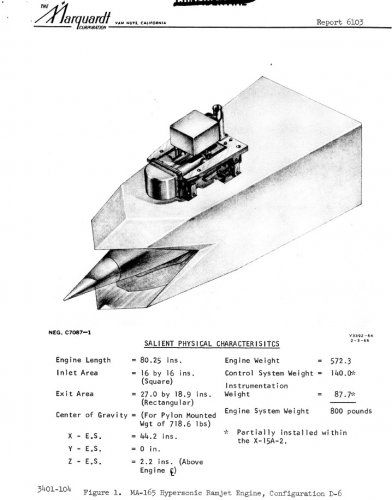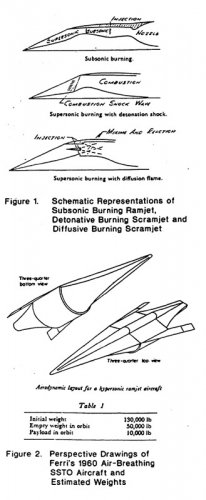HYPERSONIC RAMJET RESEARCH ENGINE PROJECT VOLUME I : MA-165 DESIGN DESCRIPTION
Title: Preliminary Design Report - Hypersonic Ramjet Research Engine Project
Online Source: Click to View PDF File [PDF Size: 9.0 MB]
Add'l Title Information: Volume 1; MA-165 Design Description
Author: Bendot, J. G.
Abstract: No abstract available
Collection: NASA
NASA Center: NASA (Unspecified Center)
Publication Date: Feb 28, 1966
Publication Year: 1966
Document ID: 19750070923
Accession Number: 75N77171
Subject Category: GENERAL
Report/Patent Number: NASA-CR-66230, REPT-6102-VOL-1
Contract/Grant/Task Number: NAS1-5117
Publication Information: Number of pages = 101
Language: English
Subject Terms: DYNAMIC STRUCTURAL ANALYSIS; ENGINE CONTROL; ENGINE DESIGN; ENGINE TESTS; FLIGHT TESTS; PERFORMANCE PREDICTION; SAFETY MANAGEMENT; SUPERSONIC COMBUSTION RAMJET ENGINES
Accessibility: Unclassified; Publicly available; Unlimited; No Copyright
Document Source: CASI
Updated/Added to NTRS: May 12, 2010
http://ntrs.nasa.gov/search.jsp?R=19750070923&hterms=ma-165&qs=Ntx%3Dmode%2520matchallany%26Ntk%3DAll%26Ns%3DLoaded-Date|1%26N%3D0%26Ntt%3Dma-165
Preliminary design report hypersonic ramjet research engine project. Volume 2: Appendixes
Title: Preliminary design report hypersonic ramjet research engine project. Volume 2: Appendixes
Online Source: Click to View PDF File [PDF Size: 12.3 MB]
Collection: NASA
NASA Center: NASA (Unspecified Center)
Publication Date: Feb 28, 1966
Publication Year: 1966
Document ID: 19760065228
Accession Number: 76N70269
Subject Category: GENERAL
Report/Patent Number: NASA-CR-66231, REPT-6102-VOL-2
Contract/Grant/Task Number: NAS1-5117
Publication Information: Number of pages = 300
Language: English
Subject Terms: COOLING SYSTEMS; ENGINE CONTROL; ENGINE DESIGN; FUEL SYSTEMS; HYPERSONIC FLIGHT; INSTRUMENTS; RAMJET ENGINES; RELIABILITY ANALYSIS; STRUCTURAL ANALYSIS
Accessibility: Unclassified; Publicly available; Unlimited; No Copyright
Document Source: CASI
Updated/Added to NTRS: Jul 21, 2008
http://ntrs.nasa.gov/search.jsp?R=19760065228&hterms=ma-165&qs=Ntx%3Dmode%2520matchallany%26Ntk%3DAll%26Ns%3DLoaded-Date|1%26N%3D0%26Ntt%3Dma-165
Title: Preliminary Design Report - Hypersonic Ramjet Research Engine Project
Online Source: Click to View PDF File [PDF Size: 9.0 MB]
Add'l Title Information: Volume 1; MA-165 Design Description
Author: Bendot, J. G.
Abstract: No abstract available
Collection: NASA
NASA Center: NASA (Unspecified Center)
Publication Date: Feb 28, 1966
Publication Year: 1966
Document ID: 19750070923
Accession Number: 75N77171
Subject Category: GENERAL
Report/Patent Number: NASA-CR-66230, REPT-6102-VOL-1
Contract/Grant/Task Number: NAS1-5117
Publication Information: Number of pages = 101
Language: English
Subject Terms: DYNAMIC STRUCTURAL ANALYSIS; ENGINE CONTROL; ENGINE DESIGN; ENGINE TESTS; FLIGHT TESTS; PERFORMANCE PREDICTION; SAFETY MANAGEMENT; SUPERSONIC COMBUSTION RAMJET ENGINES
Accessibility: Unclassified; Publicly available; Unlimited; No Copyright
Document Source: CASI
Updated/Added to NTRS: May 12, 2010
http://ntrs.nasa.gov/search.jsp?R=19750070923&hterms=ma-165&qs=Ntx%3Dmode%2520matchallany%26Ntk%3DAll%26Ns%3DLoaded-Date|1%26N%3D0%26Ntt%3Dma-165
Preliminary design report hypersonic ramjet research engine project. Volume 2: Appendixes
Title: Preliminary design report hypersonic ramjet research engine project. Volume 2: Appendixes
Online Source: Click to View PDF File [PDF Size: 12.3 MB]
Collection: NASA
NASA Center: NASA (Unspecified Center)
Publication Date: Feb 28, 1966
Publication Year: 1966
Document ID: 19760065228
Accession Number: 76N70269
Subject Category: GENERAL
Report/Patent Number: NASA-CR-66231, REPT-6102-VOL-2
Contract/Grant/Task Number: NAS1-5117
Publication Information: Number of pages = 300
Language: English
Subject Terms: COOLING SYSTEMS; ENGINE CONTROL; ENGINE DESIGN; FUEL SYSTEMS; HYPERSONIC FLIGHT; INSTRUMENTS; RAMJET ENGINES; RELIABILITY ANALYSIS; STRUCTURAL ANALYSIS
Accessibility: Unclassified; Publicly available; Unlimited; No Copyright
Document Source: CASI
Updated/Added to NTRS: Jul 21, 2008
http://ntrs.nasa.gov/search.jsp?R=19760065228&hterms=ma-165&qs=Ntx%3Dmode%2520matchallany%26Ntk%3DAll%26Ns%3DLoaded-Date|1%26N%3D0%26Ntt%3Dma-165


